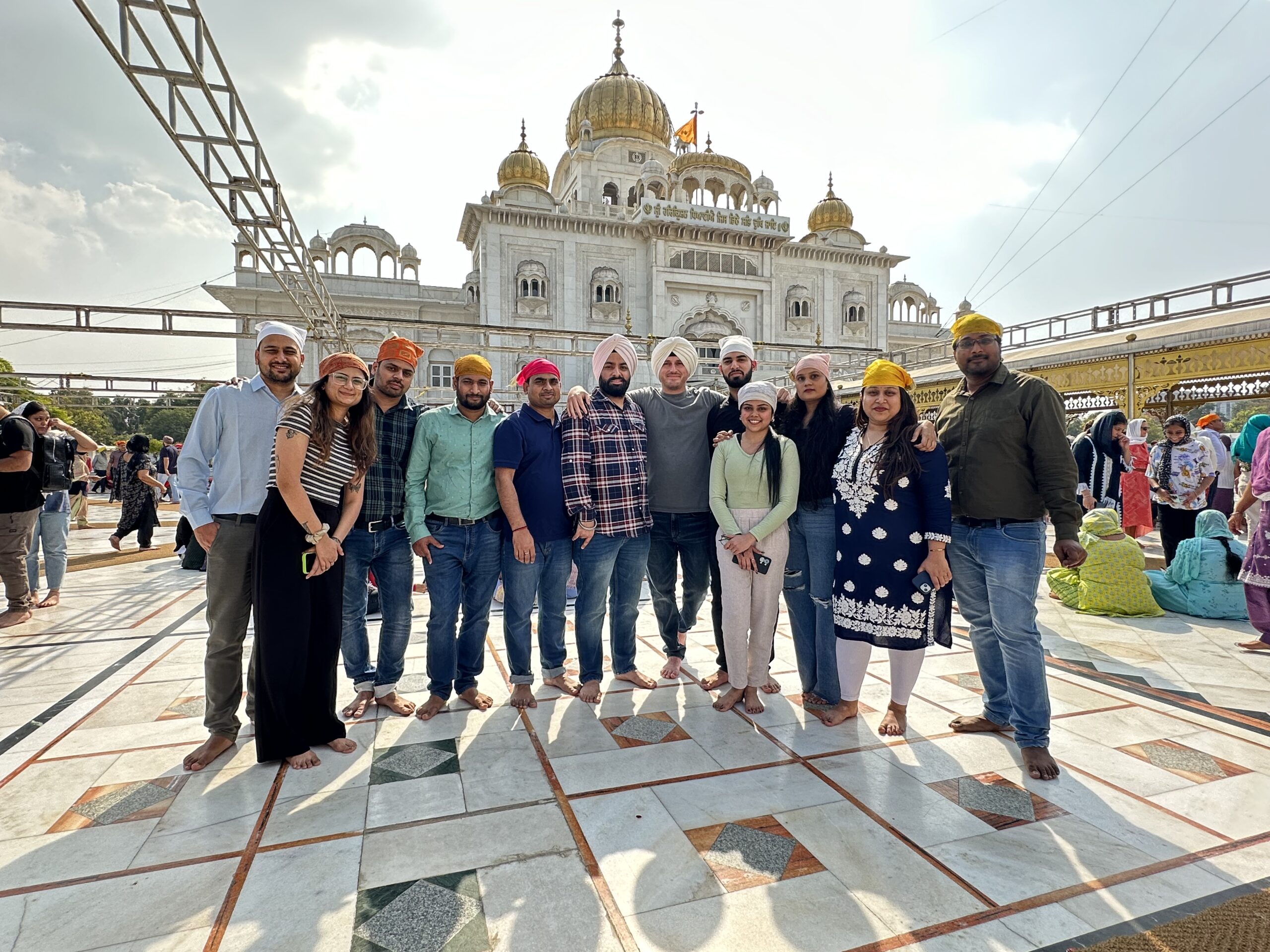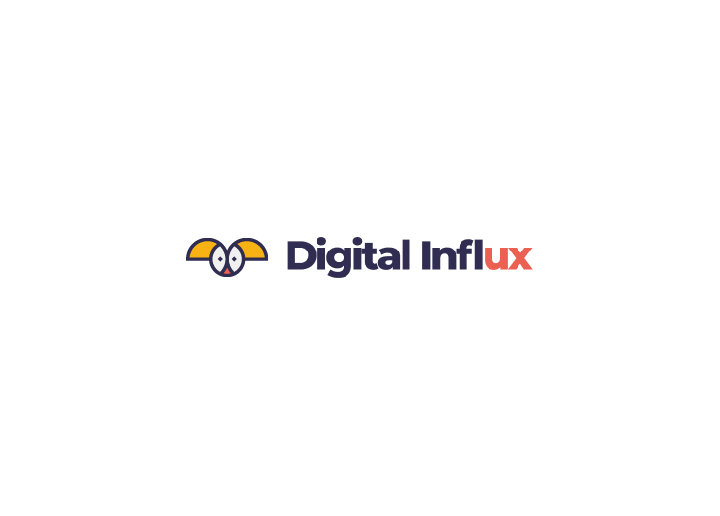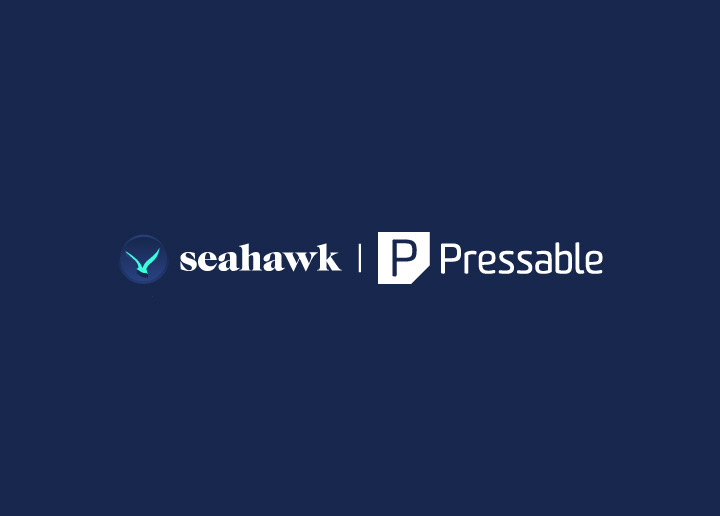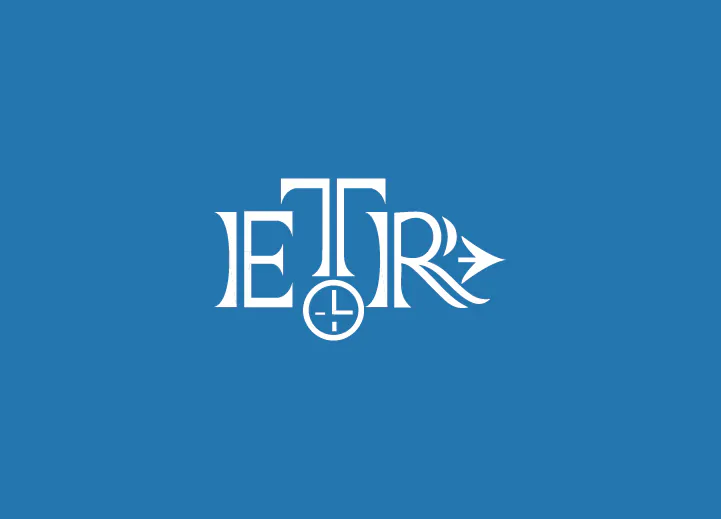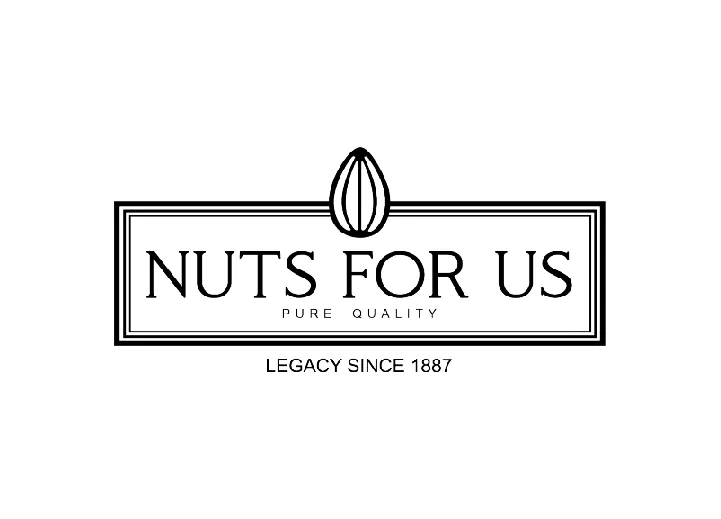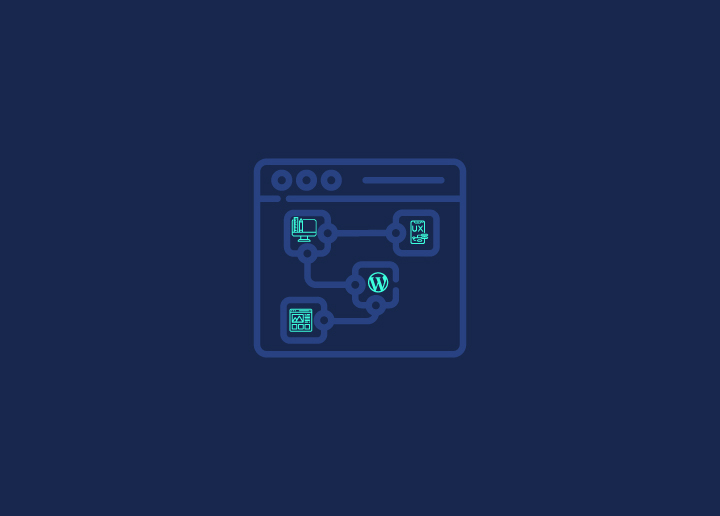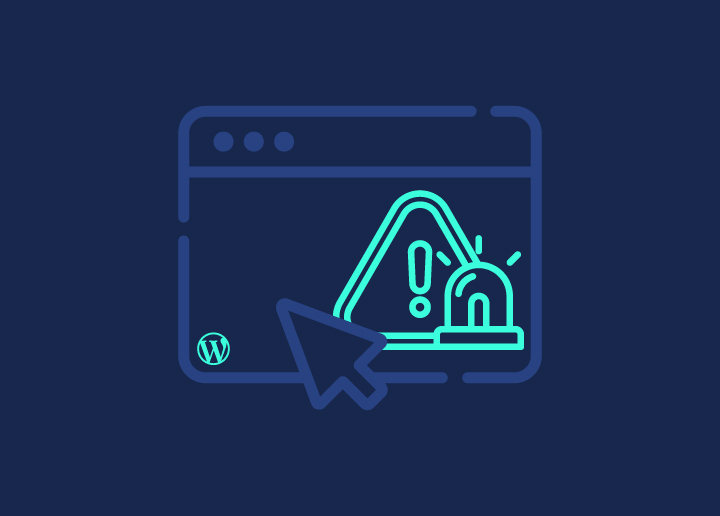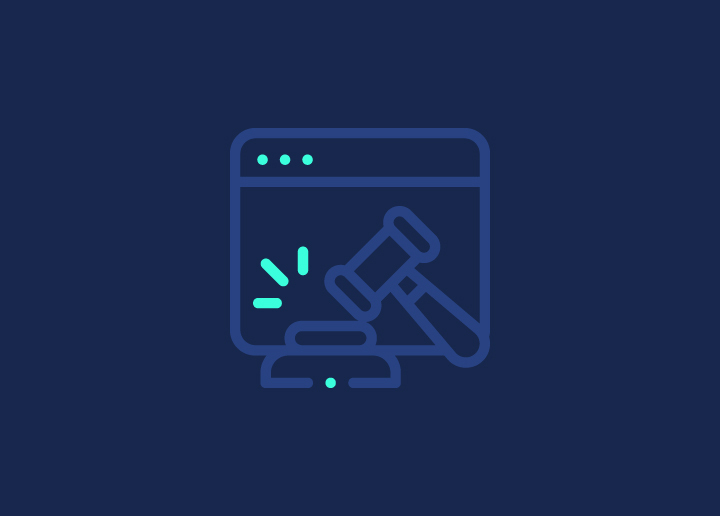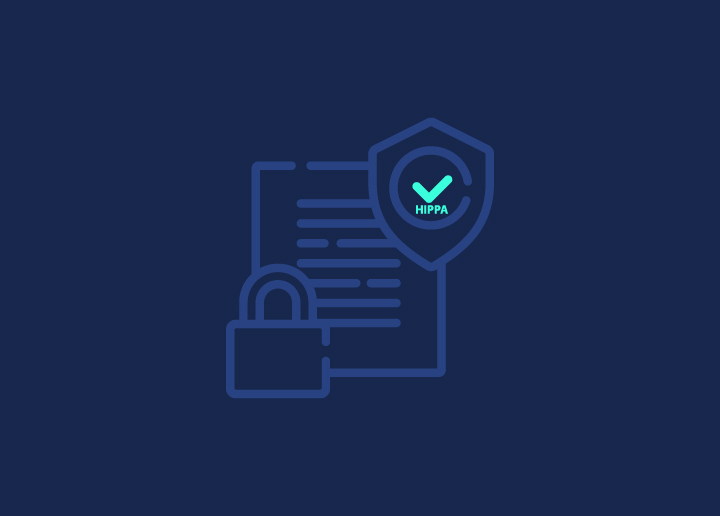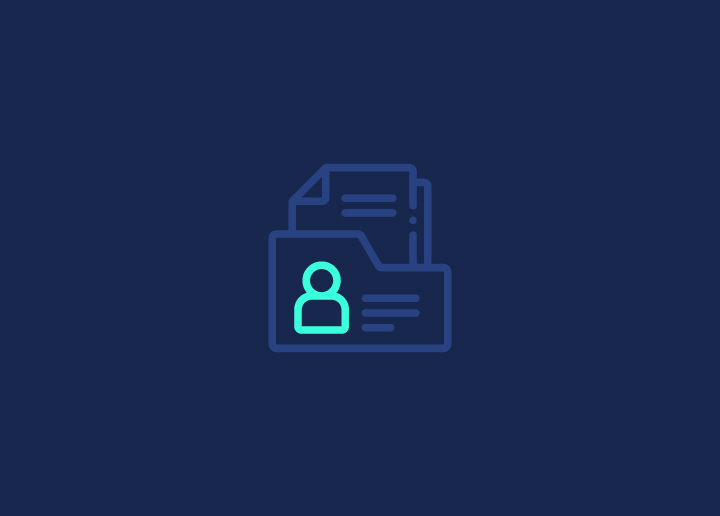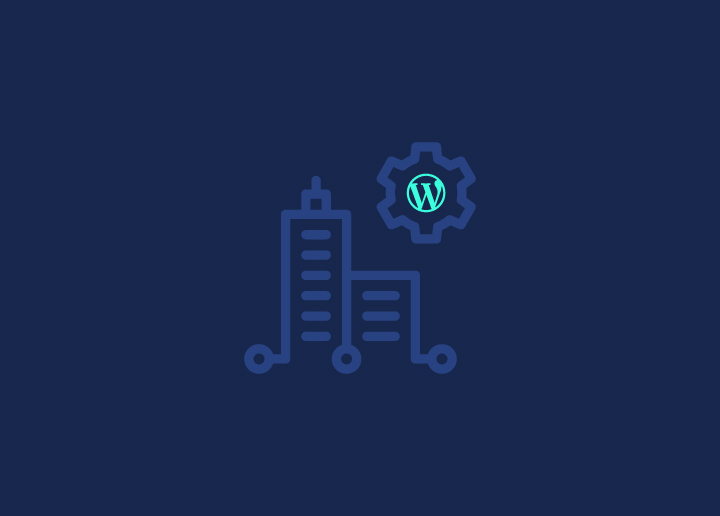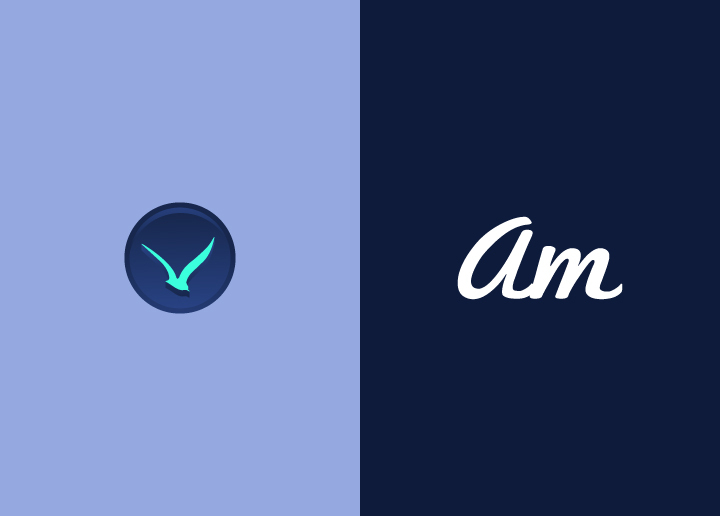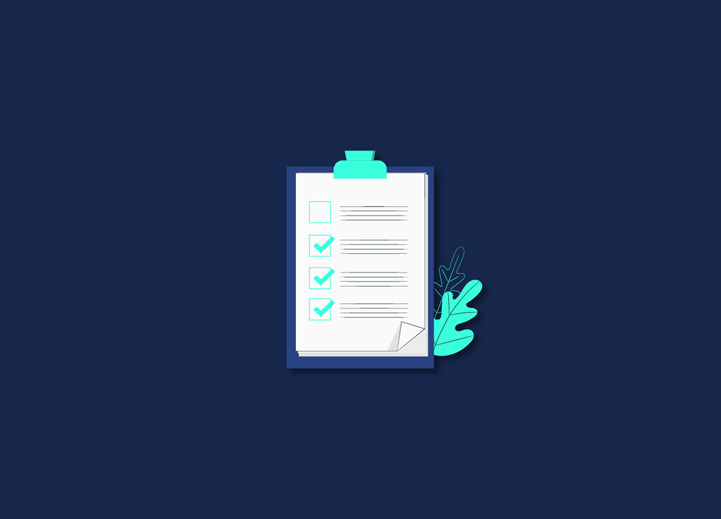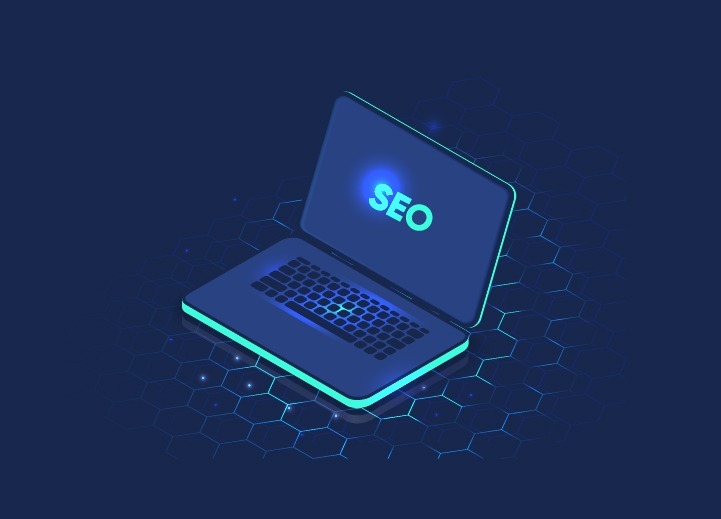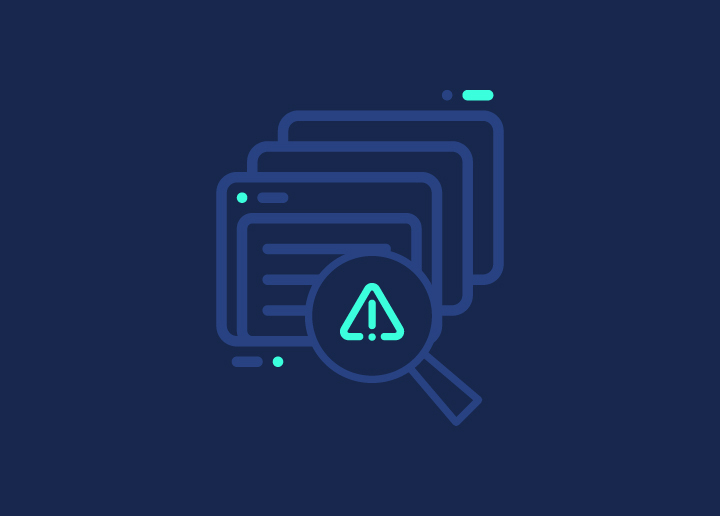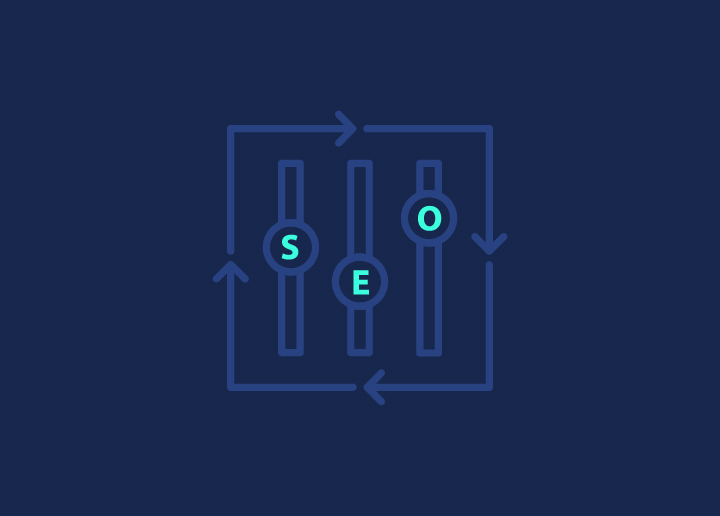It’s 2024 & if you’re still using the SEO techniques of 2011, your website is bound to fall. SEO keeps changing with time & new updates and algorithms. It is on us to keep pace with it.
Having a website is okay, but what if it isn’t visible anywhere? No point, right? That’s why you need SEO Experts who are updated with the latest trends.
Contents
ToggleSEO Checklist for 2024
Since you are here, we’ll help you with an SEO checklist to grow organic traffic to your business in 2024.
Infographic
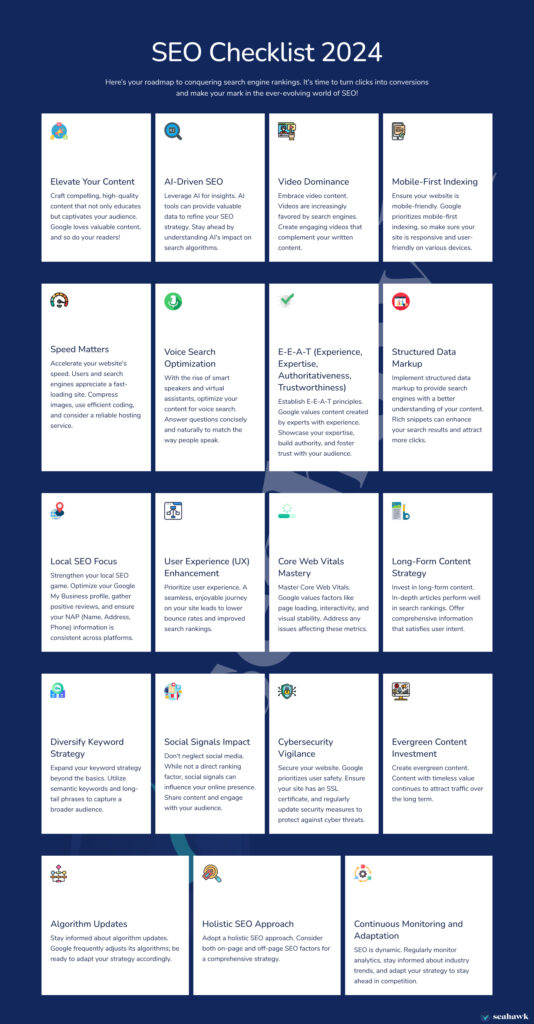
Set up Google Search Console & Bing Webmaster Tools
Imagine your website as a hidden treasure map. To ensure search engines can follow the map and uncover your digital riches, you must equip them with the right tools. In this digital quest, Google Search Console (GSC) and Bing Webmaster Tools are your compasses and magnifying glass.
By integrating Google Search Console and Bing Webmaster Tools, you’re taking a significant step toward correct indexing and troubleshooting errors. These tools provide insights into how search engines perceive your site, allowing you to detect issues that might hinder its visibility.
Setting up a Google Search Console account is a straightforward process. Head to https://search.google.com/search-console/about, sign in with your Google account, and add your website by clicking “Add a property.” Verification is essential, which can be accomplished by adding a meta tag to your homepage or uploading an HTML file to your server.
Bing Webmaster Tools follows a similar path. Visit https://www.bing.com/toolbox/webmaster, sign in with a Microsoft account, click “Add Site,” and verify your website’s ownership.
Once armed with these tools, you’ll be ready to monitor your website’s performance in search engines and tackle any challenges head-on.
Read: Growth Hacking vs Growth Marketing vs Digital Marketing
Set up Google Analytics
Understanding the pulse of your website’s traffic and performance is fundamental to refining your SEO strategy. Google Analytics offers a comprehensive view of organic traffic and user behavior, empowering you to make data-driven decisions.
Here’s a roadmap to integrating Google Analytics:
- Create a Google account if you don’t have one.
- Navigate to the Google Analytics account website and click “Sign In.”
- Enter your Google account credentials and select “Create a new account.”
- Complete the form with your account and website details, including your preferred tracking method.
- Opt for Universal Analytics and acquire your Tracking ID.
Incorporate the provided code into your website’s header. For platforms like WordPress, convenient plugins streamline this process.
With Google Analytics as your trusted ally, you’ll unlock invaluable insights into user interaction, enabling you to fine-tune your SEO strategy for optimal results.
Related: Benefits Of Outsourcing WordPress
Leverage SEO Plugins: WordPress’s Secret Weapon
If you’re navigating the seas of WordPress, you’re in luck. SEO optimization is a breeze with plugins like Yoast SEO, a versatile and user-friendly free tool, that guides you through the labyrinth of search engine optimization.
Follow these steps to install and configure Yoast SEO:
- Log in to your WordPress site and navigate to the Plugins section.
- Search for “Yoast SEO” and initiate the installation.
- After installation, activate the plugin. You’ll be ushered to the Yoast SEO Dashboard, your SEO command center. Begin by configuring General Settings, inputting your site’s name, description, and keywords. Progress to Titles & Meta Descriptions, refining settings for titles and meta description tags.
- Customize settings for individual posts and pages, ensuring each piece of content receives the SEO attention it deserves.
Similar plugins like Rank Math can also be advantageous, amplifying your website’s SEO capabilities.
Read: What Is Remarketing In PPC
Keyword Integration and Optimization
Keywords are the threads that weave the intricate tapestry of effective SEO. Strategically interweaving relevant keywords throughout your content enhances your website’s visibility and connects it with search engine users.
Mastering keyword integration involves more than mere repetition – it requires a delicate balance of art and science. Incorporate keywords like “search engine,” “SEO strategy,” and “search engine crawlers” organically and seamlessly into your content. This not only appeases search engine optimization algorithms but also provides value to your audience.
Remember, quality trumps quantity. Each keyword should serve a purpose, contributing to the coherence and value of your content. Remember the user intent behind these keywords, ensuring your content aligns with their needs.
Read: Social Media Strategies For Your Small Business
On-Page SEO Checklist
The art of on-page SEO lies in optimizing your website’s elements to enhance its search engine rankings and overall online visibility. Dive into this comprehensive checklist to ensure your on-page optimization strategy is finely tuned for success:
URL Structure: Your SEO Pathway
Crafting an effective URL structure is akin to creating a clear pathway to your digital content. Follow these steps to pave the way for optimal SEO performance:
- Keyword Inclusion: Seamlessly integrate your targeted keyword into the URL. This helps search engines decipher your page’s content and improves your click-through rate (CTR) by giving users a preview of what to expect.
- Short & Clean URLs: Aim for concise, relevant URLs without unnecessary numbers or symbols. Short URLs often receive preferential treatment from search engines, potentially boosting rankings.
Title Tag: A Captivating Introduction
Your title tag is your website’s first impression on search engines and users. Here’s how to make title tags and optimize it for impact:
- Keyword Placement: Skillfully incorporate your targeted keyword into the title tag. This gives search engines a clear signal about your page’s subject matter.
- Keyword at the Top: Elevate the impact of your keyword by positioning it at the beginning of the title tag. This helps grab users’ attention and improves search engine recognition.
- CTA-Boosting Elements: Consider enhancing your title with terms like “best,” “checklist,” “guide,” and the current year. Such additions can improve click-through rates and rankings as search engines recognize updated and valuable content.
Read: Ultimate White Label SEO Guide For Agencies
Headings: Structured Content Presentation
Proper heading structure not only enhances content readability but also assists search engines in comprehending your content’s hierarchy and relevance:
- Order of Headings: Organize your content logically by adhering to the hierarchy of headings—H1, H2, H3, H4. This clarifies the flow of information and aids both users and search engines.
- Keyword Integration: Infuse your headings with your target keyword to give search engines additional context about your content’s theme. This empowers search engines to grasp your content’s relevance more accurately.
Image Optimization: Enlightening Visuals
While humans are visual creatures, search engines need assistance in understanding images. Follow these image optimization steps for search engine results:
- Alt Tags & File Names: Elevate your images’ SEO value by optimizing them with descriptive alt tags and file names that include relevant keywords. This helps search engines interpret the content of your photos.
- Alt Text Match: Align your alt text with the image’s file name. This simple step bridges the understanding gap for search engines, enabling them to comprehend your image’s content more effectively.
Keywords & LSI (Latent Semantic Indexing): The Power of Context
Strategic keyword use and related terms can significantly impact your SEO success. Here’s how to target keywords and wield them effectively:
- Avoid Keyword Stuffing: Rather than overwhelming your content with excessive keywords, embrace synonyms and LSI keywords. This enriches your content’s context and aids in effective communication.
Linking: Building Bridges of Authority
Both external links and internal links contribute to your on-page optimization strategy, enhancing your website’s authority and user experience:
- External Linking: Reference high-authority and credible websites in your content to bolster your credibility and expertise. This not only aids users in finding supplementary information but also pleases search engine algorithms.
- Internal Linking: We have internal links to guide users and search engine crawlers through your site’s essential sections. This strategy enhances user experience, aids in content discovery, and can positively influence keyword rankings.
By following these on-page SEO practices, you’ll be well on your way to improving your website’s visibility, user experience, and search engine rankings.
Read: Best WordPress SEO Agencies
Technical SEO Checklist
Implementing strong technical SEO practices is crucial for enhancing your website’s performance, user experience, and search engine rankings. Below is a comprehensive checklist to ensure your technical SEO is up to par while seamlessly integrating the targeted keywords you’ve mentioned.
SSL Certificate – Establishing Trust and Security
The foundation of online security and user trust begins with a robust SSL certificate. Strengthen your website’s security and credibility with these steps:
- Migrate to HTTPS: Transition from HTTP to HTTPS to secure data transmission and build user trust. Search engines also favor secure websites when ranking search results.
- Visual Verification: Ensure the presence of the padlock icon in the URL bar, assuring users of a secure connection. If it’s absent, it’s time to step towards HTTPS.
Duplicate Content Management – Navigating Clarity
Avoiding duplicate content is crucial for user clarity and search engine optimization. Streamline your website’s presentation with these actions:
- Canonical URLs: Utilize canonical tags to indicate the preferred version of a page, preventing duplicate content issues.
- Redirect Alternates: Properly redirect alternate versions (www/non-www, HTTP/HTTPS) to a single canonical version for consistent indexing.
Page Loading Speed – Accelerating User Experience
Page loading speed directly impacts user satisfaction and search engine rankings in the fast-paced digital landscape. Elevate your website’s speed with these optimizations:
- Image Compression: Optimize images for the web to reduce file sizes and enhance loading speed.
- Minimize HTTP Requests: Streamline your website’s design by minimizing the number of external requests and enhancing load times.
Broken Link Management – Enhancing User Journeys
Seamless navigation is a cornerstone of user experience. Prevent broken links from hindering user journeys with these strategies:
- Regular Audits: Conduct routine audits to identify and repair broken links, ensuring a smooth browsing experience.
- Custom 404 Page: Design a user-friendly 404 error page that guides users to relevant content.
Learn: Reasons To Avoid Cheap Hosting For WordPress Websites
Mobile Optimization – Catering to the Mobile Audience
With mobile-first indexing, mobile optimization is a priority. Satisfy mobile users and bolster rankings with these practices:
- Responsive Design: Implement responsive design principles to ensure seamless performance across various devices.
- Mobile Page Speed: Optimize page speed for mobile users to provide fast and efficient experiences.
Structured Data Markup – Enhancing Search Visibility
Structured data provides context to search engines, leading to enhanced search visibility. Leverage structured data for improved results:
- Schema Markup: Implement schema markup to provide search engines with essential information about your content.
- Rich Snippets: Enable rich snippets to enhance search listings with additional information, increasing click-through rates.
XML Sitemap – Guiding Search Engines
An XML sitemap aids search engines in crawling and indexing your website effectively. Optimize this crucial element for better visibility:
- Generate XML Sitemap: Create an XML sitemap to provide search engines with a clear website structure roadmap.
- Regular Updates: Keep your XML sitemap updated and submit it to search engines for optimal crawling.
Read: How To Lazy Load Images And Videos In WordPress
Robots.txt File – Directing Crawlers
The robots.txt file guides search engine crawlers on which pages to access and index. Craft a well-structured robots.txt file for controlled crawling:
- Disallow Irrelevant Pages: Use robots.txt to prevent crawlers from accessing irrelevant or duplicate content.
- Allow Crawling of Key Pages: Ensure search engines can access your crucial content by allowing the crawling of relevant pages.
Mobile-Friendly Design – A Must for Modern SEO
In the era of mobile dominance, a mobile-friendly design is paramount for both user experience and rankings:
- Responsive Layout: Craft a responsive website layout that adjusts seamlessly across devices, optimizing user interaction.
- Mobile Usability Test: Conduct a mobile usability test to identify and rectify issues hindering mobile user experiences.
By seamlessly incorporating these targeted keywords and optimizing your website’s technical aspects, you’ll enhance your website’s performance, user experience, and search engine rankings.
Content Checklist
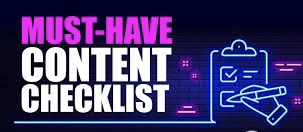
In SEO, the content game has changed to a great extent in the last ten years. In 2022, the Google search algorithm keeps a check on the content to the extent that it is now penalizing the websites that it thinks to be spam.
Now you know why you must provide high-quality content. Do not worry; here’s a checklist for your ease.
Do’s:
- Original Storytelling: Immerse your audience in unique narratives that resonate. Craft content that stands out, offering fresh perspectives and insights.
- Heading Mastery: Harness the power of headings to structure your content effectively. Utilize headings to break down complex ideas, guiding readers through the content seamlessly.
- Link to Authority: Enhance your content’s credibility by including links to authoritative sources. This supports your claims and reinforces your position as a reliable information hub.
- Meta Magic: Optimize meta tags, including meta titles and descriptions, to accurately reflect your content’s essence. Craft compelling meta descriptions that entice users to click through.
- Content Audits: Consistently evaluate your existing content to ensure it remains relevant and valuable. Update outdated information and improve user experiences.
Know: New Web Design Trends
Don’ts:
- Keyword Overload: Steer clear of keyword stuffing, an outdated practice that hampers readability and authenticity. Prioritize natural language and meaningful content flow.
- Plagiarism Alert: Plagiarism tarnishes your credibility and harms SEO efforts. Always produce original content and attribute sources when necessary.
- Keyword Cannibalization: Avoid competing with yourself by targeting the exact keywords across multiple pages. This can lead to confusion for search engines and users alike.
Related: SEO Practices To Avoid
Enhancing Content Quality: Beyond the Checklist
While the checklist provides a solid foundation, true content excellence requires a more profound commitment. Here are additional strategies to elevate your content strategy:
1. User-Centric Approach: Understand your target audience’s needs, preferences, and pain points. Tailor your content to provide solutions and value.
2. Visual Appeal: Integrate visual elements like images, infographics, and videos to enhance engagement and comprehension.
3. Storytelling Mastery: Develop a compelling narrative that draws readers in and keeps them invested throughout the content.
4. In-Depth Research: Back your claims with thorough research and data, establishing your authority within your niche.
5. Long-Form Content: While quality is paramount, longer articles often provide more comprehensive insights and have the potential to rank higher in search results.
6. Engagement and Interactivity: Encourage reader participation through comments, surveys, and interactive elements, fostering a sense of community.
7. Voice Search Optimization: Optimize your site structure and content for voice search queries, considering the natural language users employ.
8. Evergreen and Trending Content: Blend evergreen content that remains relevant over time with trending topics to keep your content fresh and appealing.
9. Analytics Insights: Continuously monitor content performance using analytics tools. Identify what resonates with your audience and adjust your strategy accordingly.
10. Regular Updates: Keep your content updated as the digital landscape evolves. This demonstrates your commitment to accuracy and relevance.
Know: How To Do An In-depth SEO Audit
Link Building Checklist
Love it or hate it, link building is an essential part of SEO. In simple terms, it means that the more website linking to yours, the more authority you will have in the search engines.
Not to forget, link building is not the primary thing to follow but also not something your business can ignore after reaching a particular stage. It is important to note that link-building has also changed drastically in the past few years.
Here’s a correct & genuine way to build links.
The first thing you can do is, identify websites similar to your niche. Reach out to them to gain links in exchange for good-quality content.
Second, Analyze your competitor’s link profile to outrank them. Reach out to websites that link to your competitor but not you. The competition is the number of referring domains between you & your competitors.
Off-Page SEO checklist
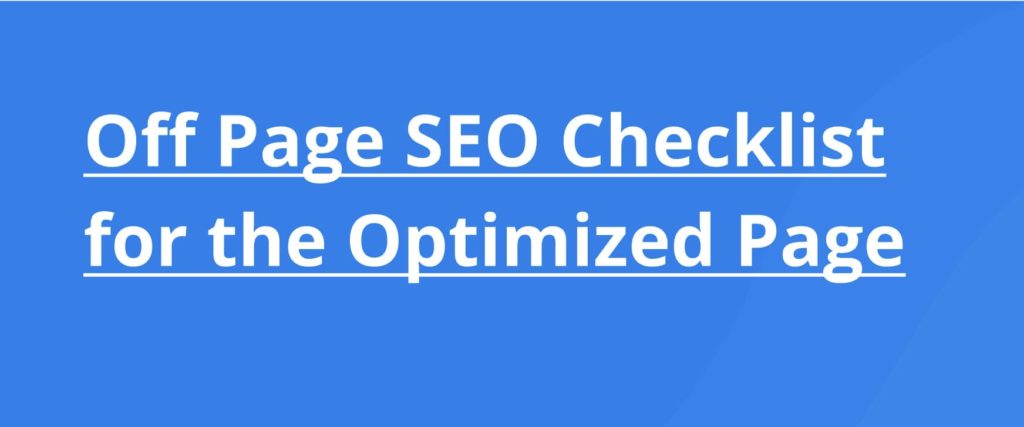
Off-page SEO is optimizing your web pages to rank higher in search engine results pages (SERPs). The main goal of off-page SEO is to build links to your website.
There are many ways to build links, but not all methods are created equal. Some techniques, like link buying, can hurt your website’s ranking. That’s why it’s essential to carefully consider your link-building strategy and use only white hat methods.
To help you get started, we’ve put together an off-page SEO checklist of tried-and-true link-building tactics:
Create High-quality Content
Creating compelling, shareable content is one of the best ways to earn natural links to your website. Make sure your site’s content is well-researched and relevant to your audience. Avoid posting duplicate content.
Reach out to Influencers and Ask for Mentions
If you know of any influencers in your industry, reach out and ask if they would be willing to mention or link to your website in their next blog post or social media update. Most influencers are happy to help other businesses in their field if the request is made politely and without strings attached.
Guest Posts on Other Blogs
Guest posting is a great way to get your name and website in front of a new audience while earning valuable backlinks. When writing a guest post, ensure it’s of the highest quality and adds value to your blog.
Learn: Top 7 Rank Tracking & Keyword Manager Tools
Participate in Forums and Comment on Blogs
When participating in industry-related forums or leaving comments on other people’s blogs, make sure your comments are relevant and insightful. You can also include a link to your website in your signature or profile, as long as it’s not too spammy.
Submit Your Website to Directories
Submitting your website to online directories is easy to build links, but only if you choose quality directories with related keywords to your specific field or niche. Submitting your website to irrelevant directories can hurt your ranking instead of helping it.
Take Advantage of Social Media Marketing
Social media platforms offer great opportunities for businesses to get their name out there and earn natural links from other users who share their content. Ensure you’re actively promoting your content on all major social media networks, including Twitter, Facebook, Google+, Instagram, and LinkedIn.
Run a Link Building Campaign with Outreach Emails
Reaching out directly to bloggers, influencers, and websites in your industry is one of the most effective link-building methods, but it can also be very time-consuming. Use an outreach email template and track your progress to ensure you get the best results possible.
Read: Best SEO Plugins For WordPress
Wrapping it up
SEO is an ever-changing thing. To keep up with good rankings & conversions, one must not try to fool the algorithm but walk with it. Here we gave an entire SEO checklist for 2024, whether for content, on-page SEO, or off-page optimization. Use this SEO checklist for the best results.
Improve your SEO presence with Seahawk with our managed SEO services, where we help boost your organic rankings & outrank your competitors. With Seahawk, Site monitoring + SEO + tracking results = Better ranking & conversions
Contact us now to leave your competitor behind!

